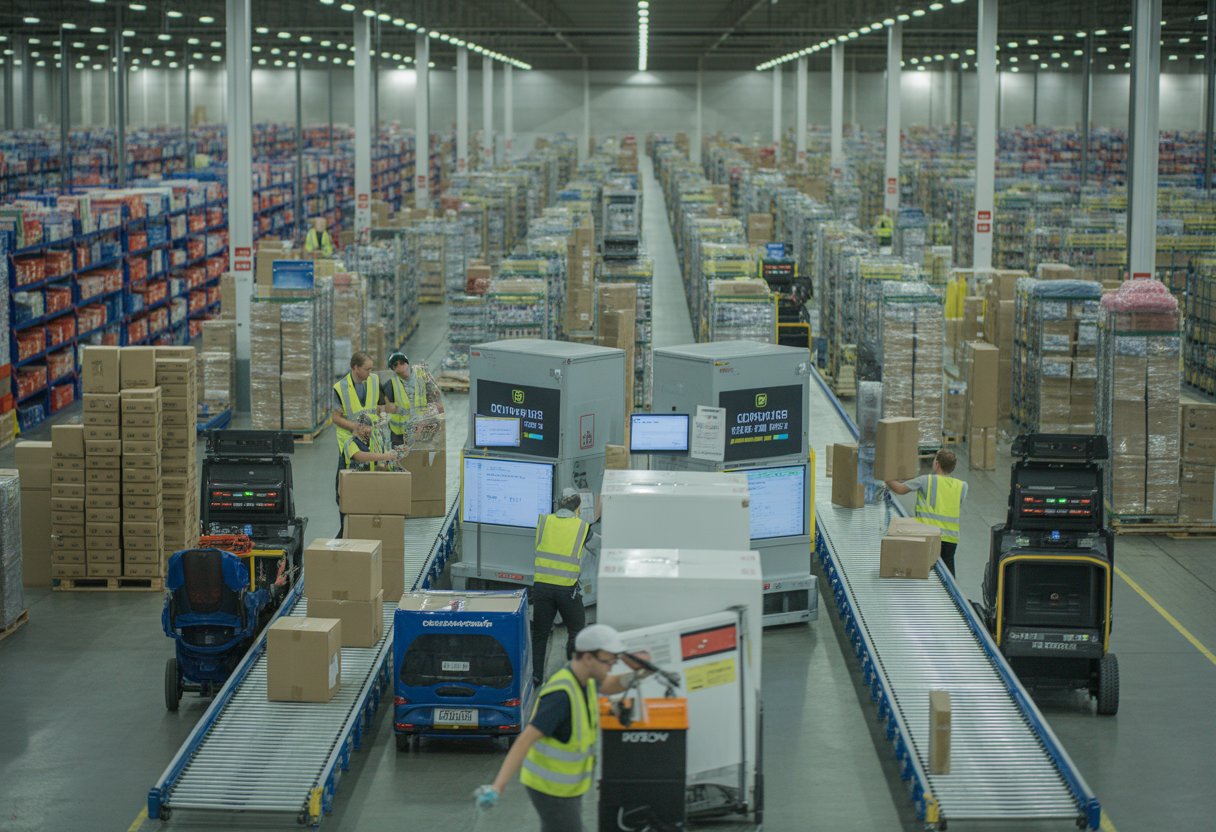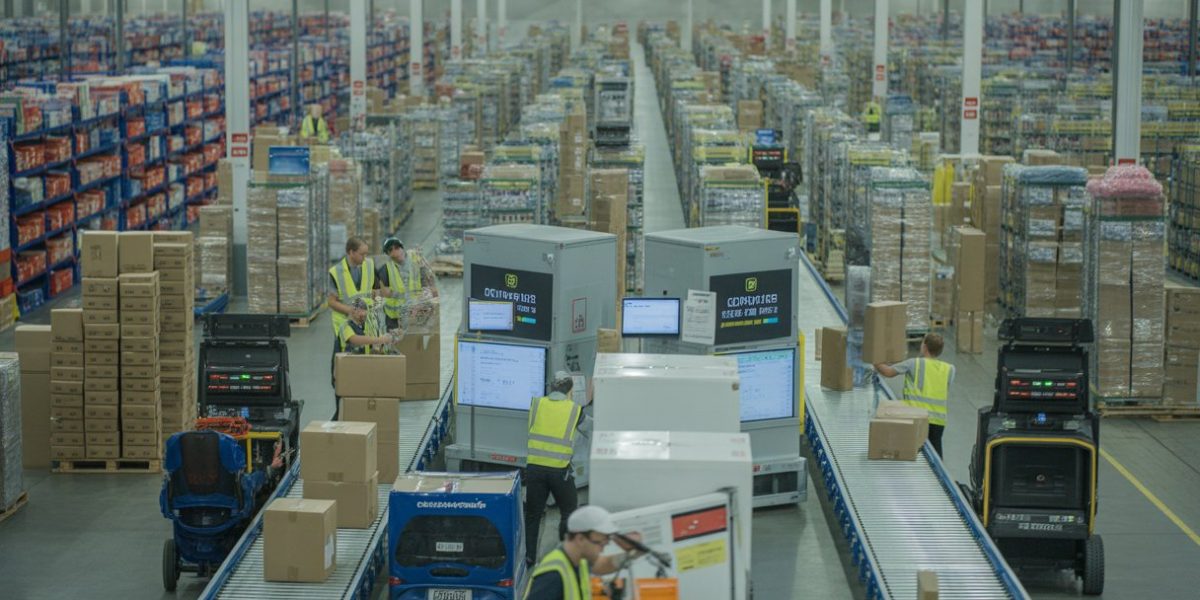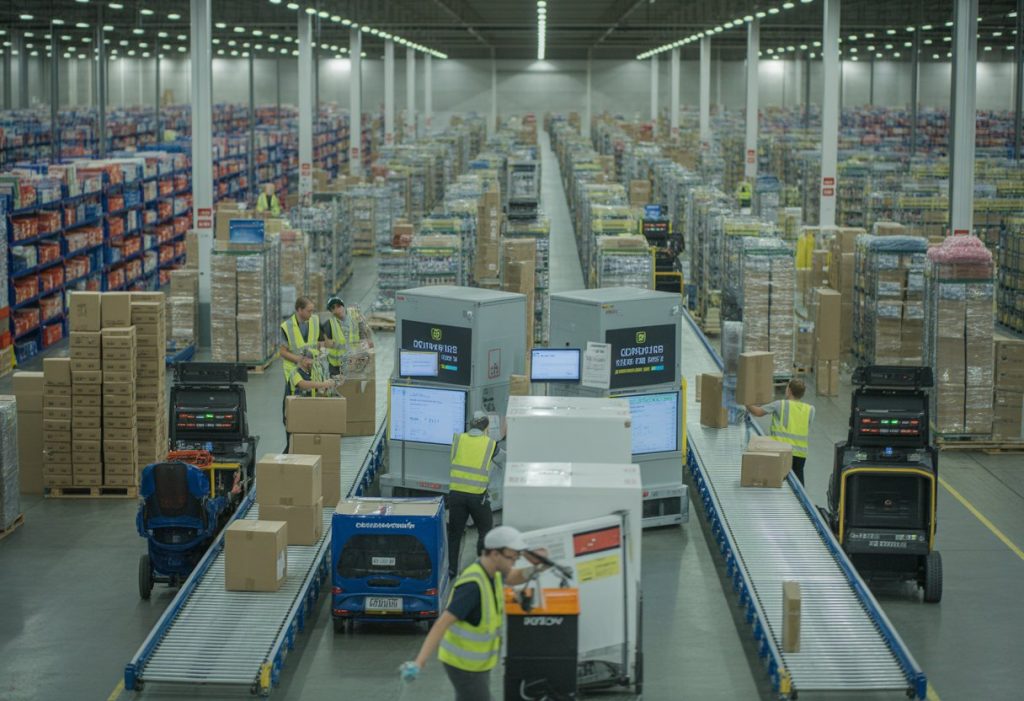When customers click “buy now,” they expect their orders to arrive quickly. Warehousing and fulfillment centres serve as the backbone of fast delivery by positioning products closer to customers and streamlining the picking, packing, and shipping process. These facilities have become essential for businesses trying to meet customer demands for same-day and next-day delivery.

Modern warehouses use strategic locations and advanced systems to process orders faster than ever before. Companies place their fulfillment centres near major shipping hubs and customer populations to reduce delivery times. This approach helps businesses stay competitive in today’s fast-paced market.
The success of fast delivery depends on how well warehouses manage inventory, adapt to changing demand, and optimise their operations. This article explores how warehousing strategies impact delivery speed, customer satisfaction, and business efficiency whilst examining the systems that make rapid order fulfillment possible.
The Role of Warehousing and Fulfilment Centres in Fast Delivery

Warehousing and fulfilment centres serve as the backbone of modern e-commerce by positioning inventory closer to customers and creating direct connections between businesses and their end users. These facilities enable the rapid order processing that customers expect in today’s competitive market.
Centralising Inventory for Rapid Dispatch
Warehouses and fulfilment centres create strategic inventory hubs that dramatically reduce delivery times. By storing products closer to major population centres, these facilities eliminate the delays caused by long-distance shipping from manufacturers.
Fulfilment centres specialise in rapid order turnover. Unlike traditional warehouses that focus on long-term storage, these facilities prioritise quick processing and same-day shipping capabilities.
Modern fulfilment centres use advanced automation systems to speed up order processing. Automated picking systems and conveyor belts move products efficiently through the facility. This technology reduces the time between order placement and dispatch.
Location strategy plays a crucial role in delivery speed. Companies position their warehousing facilities near major transport hubs and urban areas. This approach minimises the final delivery distance to customers.
Bridging the Gap Between Businesses and Customers
Fulfilment centres act as direct intermediaries between businesses and their customers. They handle the entire order process from receiving to shipping. This eliminates multiple handling stages that slow down traditional supply chains.
These facilities provide order visibility throughout the delivery process. Customers receive real-time updates about their orders. This transparency builds trust and manages delivery expectations effectively.
Multi-channel distribution becomes possible through centralised warehousing. Businesses can serve online orders, retail stores, and wholesale customers from the same facility. This flexibility improves overall supply chain efficiency.
Distribution centres standardise packaging and shipping processes. Consistent handling reduces errors and speeds up the entire fulfilment process. Professional packaging also protects products during transit.
How Warehousing and Fulfilment Centres Optimise Order Fulfilment

Warehousing and fulfilment centres use specific systems and processes to speed up order processing. They focus on efficient picking methods, quality control checks, and strong shipping networks to meet customer expectations.
Order Processing Efficiency
Modern fulfilment centres use technology to process orders faster than traditional warehouses. They rely on warehouse management systems to track inventory and guide workers through each step.
Automated order routing sends new orders straight to the picking area. This cuts down waiting time between when a customer places an order and when workers start collecting items.
Smart warehouse layouts group similar products together. This design helps workers find items quickly without walking long distances. The setup reduces the time needed for each order.
Real-time inventory tracking prevents overselling. The system updates stock levels as soon as workers pick items. This accuracy helps avoid delays from out-of-stock situations.
Many centres use barcode scanning at each step. Workers scan items when picking and packing to reduce mistakes. Fewer errors mean less time spent fixing problems later.
Pick and Pack Operations
Pick and pack operations form the heart of order fulfilment in warehouses. Workers collect items from storage areas and prepare them for shipping in one smooth process.
Zone picking divides the warehouse into sections. Each worker handles orders in their assigned area. This method reduces travel time and lets workers become experts in their zone.
Batch picking allows workers to collect items for multiple orders at once. They sort products later at packing stations. This approach works well for centres handling many small orders.
Pick-to-light systems guide workers using LED displays. Lights show exactly which items to collect and how many. These systems cut picking errors and speed up the process.
Packing stations have all materials ready for workers. Pre-cut boxes, labels, and protective materials stay within easy reach. This organisation keeps the packing process moving smoothly.
Quality Control and Packaging
Quality control steps ensure customers receive the right products in good condition. Fulfilment centres build these checks into their daily operations without slowing down shipping.
Double-checking systems require workers to verify each item before packing. Many centres use barcode scanners to match picked items against order lists. This step catches most errors before products leave the facility.
Packaging standards protect items during shipping. Workers choose appropriate box sizes and add protective materials based on product type. Proper packaging reduces damage and returns.
Weight verification systems check packed orders automatically. If a package weighs too much or too little, the system flags it for review. This catch prevents shipping errors.
Photo documentation records what goes into each package. Some centres take pictures before sealing boxes. These records help resolve customer complaints quickly.
Shipping and Logistics Network
Strong shipping networks give fulfilment centres multiple delivery options for customers. These centres work with several carriers to find the fastest and most cost-effective routes.
Carrier partnerships provide different shipping speeds and prices. Centres can offer same-day, next-day, or standard delivery based on customer needs. Multiple options improve customer satisfaction.
Strategic warehouse locations reduce shipping distances. Companies place fulfilment centres near major population areas. Shorter distances mean faster delivery times and lower shipping costs.
Shipping zones help determine the best carrier for each order. The system automatically selects carriers based on destination, package size, and delivery speed. This automation optimises shipping costs.
Last-mile delivery partnerships extend reach to remote areas. Local courier services help fulfil orders in places where major carriers struggle. These partnerships ensure consistent service across all locations.
Inventory Management Strategies for Speed and Accuracy
Fast delivery depends on having the right products in the right places at the right time. Modern warehouses use real-time tracking systems, prevent stock issues through smart planning, and rely on advanced technology to maintain accuracy whilst meeting speed demands.
Real-Time Inventory Tracking
Real-time inventory tracking gives warehouses instant visibility into stock levels across all locations. This system updates automatically when items move in or out of storage areas.
RFID tags and barcode scanners capture data immediately when workers handle products. The information flows directly to central databases without delays.
Modern tracking systems show exact quantities and locations on digital dashboards. Warehouse managers can see which items are running low before they run out completely.
Key benefits include:
- Instant stock level updates
- Reduced counting errors
- Faster order processing
- Better space planning
Real-time data helps workers find products quickly during picking operations. This reduces the time spent searching for items and speeds up order fulfilment.
The system also tracks product movement patterns. Warehouses can identify which items move fastest and place them in easy-to-reach locations.
Preventing Stockouts and Overstocking
Stockouts happen when popular items run out completely. Overstocking occurs when warehouses hold too much slow-moving inventory.
Both problems hurt delivery speed and increase costs. Smart inventory management prevents these issues through careful planning.
Warehouses set minimum and maximum stock levels for each product. The system alerts managers when items reach these trigger points.
Automatic reorder systems place new orders when stock hits minimum levels. This prevents empty shelves without requiring constant manual checking.
Historical sales data helps predict future demand patterns. Warehouses can prepare for busy seasons and avoid excess stock during quiet periods.
ABC analysis groups products by importance:
- A items: High-value, fast-moving products
- B items: Medium-value, moderate movement
- C items: Low-value, slow-moving products
Each group gets different management strategies. A items receive closer monitoring whilst C items need less frequent attention.
Using Technology: WMS and RFID
Warehouse Management Systems (WMS) control all inventory activities from a central platform. These systems coordinate receiving, storage, picking, and shipping operations.
Modern WMS software integrates with online shops and shipping companies. Orders flow automatically from websites to warehouse floors without manual data entry.
The system assigns optimal storage locations based on product size, weight, and demand frequency. Popular items go to easily accessible areas near packing stations.
RFID technology uses radio waves to track products without direct scanning. Workers can count entire shelves instantly by walking past with RFID readers.
RFID tags store more information than traditional barcodes. Each tag can hold product details, expiry dates, and location history.
WMS features that improve speed:
- Automated picking routes
- Real-time stock updates
- Integration with shipping systems
- Mobile device support
These technologies work together to eliminate manual paperwork and reduce human errors. Workers receive picking instructions on handheld devices that update automatically when tasks finish.
Scalability, Flexibility, and Adapting to Demand
Modern warehousing systems must scale with business growth whilst maintaining flexibility to handle unexpected market shifts. These facilities adapt quickly to supply chain disruptions through strategic planning and technology integration.
Supporting Business Growth
Warehouses support business expansion through scalable infrastructure that grows with company needs. Distribution centres can increase storage capacity and processing power during peak periods without requiring new facilities.
Many retailers use flexible warehousing models that adjust space allocation based on seasonal demands. This approach reduces fixed costs whilst maintaining service levels during busy periods.
Scalable systems include:
- Modular storage solutions that expand vertically and horizontally
- Automated systems that handle increased order volumes
- Flexible staffing models for peak seasons
- Technology that processes more orders without major upgrades
Businesses benefit from warehouse-as-a-service models that provide on-demand storage without long-term commitments. These services allow companies to test new markets or handle temporary growth without investing in permanent infrastructure.
Returns management also scales with business growth. Efficient return processing systems handle increased volumes whilst maintaining customer satisfaction levels.
Flexible Distribution Solutions
Distribution centres offer multiple service options that adapt to changing customer needs. Flexible logistics solutions include same-day delivery, next-day shipping, and standard delivery options from the same facility.
Modern distribution strategies feature:
- Multiple shipping carriers for optimal delivery times
- Variable packaging options for different product types
- Cross-docking capabilities for faster throughput
- Regional distribution networks that reduce delivery distances
Micro-fulfilment centres represent a flexible approach to urban delivery. These smaller facilities position inventory closer to customers whilst reducing last-mile logistics costs.
Technology integration enables real-time adjustments to distribution patterns. Warehouses can redirect inventory between locations based on demand patterns and supply availability.
Flexible space allocation allows warehouses to handle different product categories efficiently. Facilities can quickly reconfigure storage areas for seasonal merchandise or new product lines.
Adapting to Supply Chain Disruptions
Supply chain disruptions require immediate warehouse adaptations to maintain service levels. Facilities use contingency planning and backup systems to handle unexpected challenges.
Warehouses adapt to disruptions through diversified supplier networks and alternative sourcing strategies. Multiple supplier relationships reduce dependency on single sources during shortages.
Key adaptation strategies include:
- Buffer stock management for critical items
- Alternative transportation routes and carriers
- Flexible labour scheduling during disruptions
- Real-time inventory tracking across multiple locations
Technology helps warehouses respond quickly to supply chain issues. Automated systems can redirect orders to alternative fulfilment locations when disruptions occur at specific facilities.
Retailers benefit from warehouse networks that share inventory across multiple locations. This approach ensures product availability even when individual facilities face operational challenges.
Emergency protocols enable warehouses to maintain essential operations during major disruptions. These plans include backup power systems, alternative staffing arrangements, and priority processing for critical orders.
Enhancing Customer Satisfaction and Loyalty Through Fast Delivery
Fast delivery directly impacts customer satisfaction by meeting modern shopping expectations and reducing wait times. Companies that deliver quickly build stronger customer loyalty and gain competitive advantages in today’s market.
Meeting Evolving Delivery Expectations
Customer expectations for delivery speed have changed dramatically in recent years. What shoppers once viewed as premium services are now standard requirements.
Same-day and next-day delivery options have become the norm rather than luxury services. Businesses that cannot meet these speed expectations risk losing customers to competitors who can deliver faster.
Key customer expectations include:
- Delivery within 1-2 days for standard orders
- Same-day options for urgent purchases
- Real-time tracking information
- Reliable delivery windows
Average delivery times dropped by 27% between 2023 and 2024. This shows how quickly the market is moving towards faster fulfilment standards.
Companies must adapt their warehousing strategies to meet these evolving demands. Those who fail to keep pace face declining customer satisfaction scores and reduced market share.
Reducing Delivery Times
Shorter delivery times create immediate improvements in customer satisfaction. Faster shipping reduces the anxiety customers feel while waiting for their orders.
Strategic warehouse placement near major population centres cuts shipping distances significantly. This geographical advantage allows companies to offer next-day delivery to more customers at lower costs.
Effective time reduction strategies include:
- Using multiple fulfilment centres
- Partnering with reliable courier services
- Implementing automated picking systems
- Optimising inventory placement
Technology plays a crucial role in speeding up operations. Automated systems can process orders within hours rather than days.
Businesses that reduce delivery times from five days to two days typically see customer satisfaction scores increase by 15-20%. This improvement directly translates to higher retention rates.
Building Customer Loyalty
Fast delivery creates lasting customer loyalty by exceeding service expectations consistently. Customers who receive quick shipping are more likely to make repeat purchases.
Reliable speed builds trust between businesses and their customers. When companies consistently deliver quickly, customers feel confident placing future orders.
Fast delivery impacts loyalty through:
- Increased purchase frequency
- Higher customer lifetime value
- Positive word-of-mouth recommendations
- Reduced shopping cart abandonment
Studies show that customers who experience fast delivery spend 25% more on future orders. They also recommend these businesses to friends and family more often.
Companies with efficient warehousing operations can maintain consistent delivery speeds even during peak seasons. This reliability strengthens customer relationships and builds long-term loyalty that competitors struggle to break.
Operational Efficiency and Cost Optimisation in Warehousing
Modern warehouses achieve fast delivery through strategic cost management and streamlined operations. Businesses focus on reducing expenses, maximising space utilisation, and using data analytics to drive performance improvements.
Reducing Operational Expenses
Labour costs represent the largest expense in most warehouse operations. Businesses can reduce these costs by implementing automated picking systems and conveyor belts. These technologies handle repetitive tasks whilst allowing staff to focus on complex activities.
Energy expenses form another major cost centre. Warehouses reduce electricity bills by installing LED lighting systems and motion sensors. Smart climate control systems adjust temperature based on occupancy and weather conditions.
Equipment maintenance creates ongoing operational expenses. Regular servicing prevents costly breakdowns and extends machinery lifespan. Businesses track maintenance schedules using digital systems to avoid emergency repairs.
Key cost reduction strategies include:
- Automating manual processes
- Optimising energy consumption
- Implementing preventive maintenance
- Negotiating better supplier contracts
- Cross-training staff for flexibility
Inventory carrying costs drain warehouse budgets through storage fees and tied-up capital. Companies reduce these expenses by improving demand forecasting and implementing just-in-time delivery systems.
Optimising Space and Workflow
Warehouse layout directly impacts operational efficiency and processing speed. Businesses design layouts that minimise travel distances between frequently accessed items. Fast-moving products stay near packing stations whilst slow-moving inventory occupies less accessible areas.
Vertical space utilisation maximises storage capacity without expanding floor area. High-density storage solutions include mezzanine floors and automated storage systems. These approaches increase capacity by 40-60% in existing facilities.
Material flow optimisation reduces bottlenecks and processing delays. Warehouses create dedicated pathways for inbound and outbound shipments. Clear traffic patterns prevent congestion during peak operating hours.
Effective space optimisation includes:
- Strategic product placement
- Vertical storage solutions
- Streamlined traffic flow
- Flexible storage systems
- Regular layout reviews
Zone-based picking systems group similar products together. This approach reduces picker travel time and increases order accuracy. Businesses often see 25-30% improvements in picking efficiency through proper zoning.
Leveraging Data for Efficiency
Real-time data collection enables warehouses to monitor performance and identify improvement opportunities. Warehouse Management Systems (WMS) track inventory levels, order processing times, and staff productivity. This information helps managers make informed operational decisions.
Predictive analytics forecast demand patterns and seasonal fluctuations. Businesses use this data to adjust staffing levels and inventory positions. Accurate forecasting prevents stockouts and reduces excess inventory costs.
Performance metrics guide continuous improvement efforts. Key indicators include order accuracy rates, picking speed, and inventory turnover. Regular monitoring helps identify trends and potential problems before they impact operations.
Essential data applications include:
- Inventory tracking systems
- Performance dashboards
- Demand forecasting tools
- Resource allocation models
- Quality control monitoring
Supply chain management benefits from integrated data systems that connect suppliers, warehouses, and customers. This visibility enables better coordination and faster response to disruptions or demand changes.
Frequently Asked Questions
Warehousing and fulfilment centres face several common questions about their operations and impact on delivery speed. These facilities rely on strategic location placement, advanced technology, and efficient inventory systems to meet customer expectations.
How do warehousing and fulfilment centres contribute to supply chain efficiency?
Warehousing and fulfilment centres transform static storage into dynamic distribution hubs. They streamline the entire supply chain by managing inventory, processing orders, and coordinating shipments in one location.
Fulfilment centres handle the complete order process from picking to packing to shipping. This integrated approach reduces delays between each step. Warehouses store bulk inventory closer to customers, eliminating long transport times from distant manufacturing sites.
These facilities enable businesses to maintain consistent stock levels. They prevent stockouts that would otherwise delay customer orders. The centralised operations also reduce handling errors that can cause shipping delays.
What role does location play in the effectiveness of warehousing for speedy deliveries?
Location is the primary factor determining shipping speed. Products arrive faster when warehouses sit close to customers rather than far away.
Multiple warehouse locations across different regions allow businesses to serve various markets quickly. Companies can ship from the nearest facility to each customer. This strategy significantly cuts delivery times compared to shipping from a single distant location.
Urban locations support same-day delivery options. Warehouses positioned near city centres can reach dense customer populations within hours. Strategic placement in different time zones also extends daily shipping windows.
In what ways do warehousing operations impact the delivery times experienced by customers?
Efficient picking and packing processes directly affect how quickly orders leave the warehouse. Fast processing means shorter time between order placement and shipment.
Organised warehouse layouts reduce the time workers need to locate and collect items. Systematic storage methods help staff find products quickly. Streamlined packing stations prevent bottlenecks that could delay shipments.
Order accuracy also impacts delivery times. Mistakes require returns and reshipments, which double the delivery time for customers. Well-organised warehouses maintain higher accuracy rates through better processes.
What technological advancements in warehousing support faster product delivery?
Real-time warehouse management systems track inventory levels and order status instantly. These systems prevent overselling and provide accurate delivery estimates to customers.
Automated sorting equipment speeds up order processing by quickly directing items to the correct shipping lanes. Robotic picking systems can locate and collect products faster than manual methods.
Advanced software optimises picking routes within warehouses. Workers can collect multiple orders efficiently by following computer-generated paths. Barcode scanning reduces errors and speeds up verification processes.
How does inventory management within fulfilment centres affect order processing speed?
Proper inventory placement puts popular items in easily accessible locations. Fast-moving products stored near packing areas reduce collection time. Strategic positioning minimises travel distance for warehouse staff.
Accurate stock counts prevent delays caused by out-of-stock situations. Real-time inventory tracking shows exactly what is available for immediate shipping. This information helps avoid promising delivery dates that cannot be met.
Sufficient safety stock levels ensure continuous order fulfilment. Centres maintain extra inventory of popular items to handle demand spikes. This approach prevents stockouts that would delay customer orders.
What are the typical challenges faced by warehousing and fulfilment centres in meeting delivery expectations?
Peak demand periods strain warehouse capacity and processing speeds. Holiday seasons and sales events can overwhelm normal operations. Centres must scale up temporary staff and extend operating hours to maintain service levels.
Labour shortages affect processing times when facilities cannot maintain full staffing levels. Understaffed warehouses take longer to pick, pack, and ship orders. Training new workers also temporarily reduces overall efficiency.
Inventory imbalances create bottlenecks when popular items run short whilst slow-moving products occupy valuable space. Poor demand forecasting leads to stockouts of needed items and excess storage of unwanted inventory.








